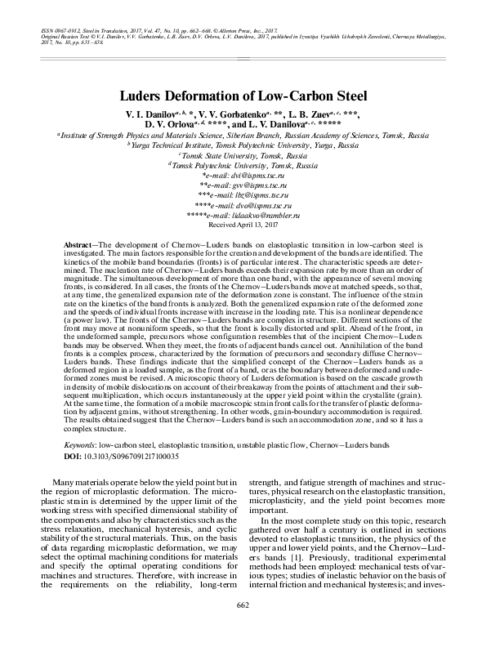Luders Deformation of Low-Carbon Steel
Abstract—The development of Chernov—Luders bands on elastoplastic transition in low-carbon steel is investigated. The main factors responsible for the creation and development of the bands are identified. The kinetics of the mobile band boundaries (fronts) is of particular interest. The characteristic speeds are determined. The nucleation rate of Chernov—Luders bands exceeds their expansion rate by more than an order of magnitude. The simultaneous development of more than one band, with the appearance of several moving fronts, is considered. In all cases, the fronts of the Chemov-Luders bands move at matched speeds, so that, at any time, the generalized expansion rate of the deformation zone is constant. The influence of the strain rate on the kinetics of the band fronts is analyzed. Both the generalized expansion rate of the deformed zone and the speeds of individual fronts increase with increase in the loading rate. This is a nonlinear dependence (a power law). The fronts of the Chemov-Luders bands are complex in structure. Different sections of the front may move at nonuniform speeds, so that the front is locally distorted and split. Ahead of the front, in the undeformed sample, precursors whose configuration resembles that of the incipient Chernov-Luders bands may be observed. When they meet, the fronts of adjacent bands cancel out. Annihilation of the band fronts is a complex process, characterized by the formation of precursors and secondary diffuse Chemov-Luders bands. These findings indicate that the simplified concept of the Chemov-Luders bands as a deformed region in a loaded sample, as the front of a band, or as the boundary between deformed and undeformed zones must be revised. A microscopic theory of Luders deformation is based on the cascade growth in density of mobile dislocations on account of their breakaway from the points of attachment and their subsequent multiplication, which occurs instantaneously at the upper yield point within the crystallite (grain). At the same time, the formation of a mobile macroscopic strain front calls for the transfer of plastic deformation by adjacent grains, without strengthening. In other words, grain-boundary accommodation is required. The results obtained suggest that the Chemov-Luders band is such an accommodation zone, and so it has a complex structure.




